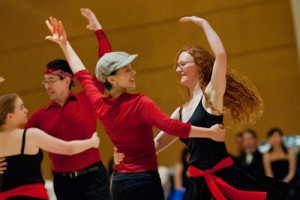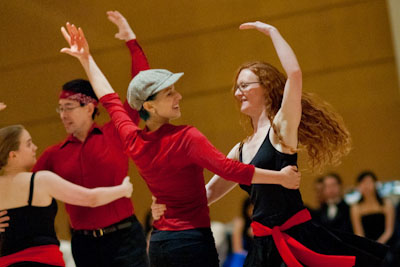Stanford Ceili brings Irish dancing to the Stanford social dance community
Stepping into the Hacienda Commons on a Tuesday a little after 7 p.m., I was greeted by the sight of two separate groups of dancers bouncing gracefully up and down in time to a drum, as if on springs. Surveying both groups that made up this Stanford Ceili practice session, I quickly determined that I should join the group learning individual steps rather than the one in the larger set.
Starting with the basics, along with my fellow beginners, we first learned the basic “sevens,” a step that involved rocking back and forth in the 6/8 time of the Irish jig music that was playing. The glassy, wood floor was perfect for spins and quick shuffles, though my socks seemed too eager to slide on the surface, and I nearly fell a few times. Slowly throughout the evening we participated in dances with more and more people, progressing from individual steps to a three-person “Galway Reel for Three” and all the way to sets involving up to 16 people. By the end of the night, my calves were burning, but the dance continued as the boundless energy of the group members carried them through the 9 p.m. ending time.

“The music is so entrancing and lively,” said Anna Polishchuk ’15, a fellow beginner. “Who wouldn’t want to dance it?”
Danya Volkov ’11, now a third-year graduate student in mechanical engineering, founded Stanford Ceili in the summer of 2010. As an undergraduate, Volkov was an active member of the social dance community on campus. She first witnessed a ceili performance at a Friday Night Waltz, a weekly event taught by Stanford dance professor Richard Powers ’70.
“There was a group of people doing Irish dance in the center of the floor,” Volkov said. “Irish dance is something I had always wanted to do when I was a child.”
This group of dancers had come from the Berkeley area, where they met to dance at centers such as the Starry Plough, a pub in South Berkeley. While Volkov was interested in joining, she had no means of traveling as an undergrad without a car. As a teaching assistant, Volkov had access to the Hasso Plattner Institute of Design at Stanford (d.school) building, and she decided to use this access to bring the ceili group to Stanford. Since the two main instructors lived closer to Stanford than to Berkeley, the new location proved convenient for them, as well. Soon, the Berkeley group was migrating to Palo Alto to satisfy its ceili fix, moving its main dance site to the Stanford campus.
“It was kind of a new building, so no one was using it over the summer,” Volkov said of the d.school. “We had this giant atrium. Five to eight people [would come] every week, mostly me and [the teachers] and whoever else we could get to come, and now it’s grown.”
Ceili takes typical Irish dance steps and combines them into an interactive form, transforming the steps into a social dance. My first three-person “Galway Reel for Three” involved taking hands with two others while performing the individual front, back and sideways “sevens,” though the figure-eight “Hey” pattern presented some difficulties. After graduating to a larger group, we wound our ways around one another, crisscrossing and swinging partners along with other group members. One particularly dizzying move was called “Around-the-House,” in which partners leaped and spun one another simultaneously, pivoting around the group until we arrived back at our original spot.
“It’s a little different than what I’d done before, with figures and a more social aspect,” said Mairi Litherland, financial officer of the group and a third-year graduate student, who had grown up performing Irish step dancing.

“But the steps are essentially the same,” Litherland added.
The group teaches new dances the first three Tuesdays of each month, while the last Tuesday is an all-dance session. While the Tuesday night class is open to any curious passersby, the core performance group consists of about 15 regulars. The group often performs at social dance events such as Jammix, Fall Ball, the Bon Bon Ball and the Viennese Ball. While several dancers are members of the social dance community, Stanford Ceili also attracts Irish step dancers not involved in social dance and individuals who may not feel comfortable with couples dancing.
“Ceili is very closely related to the following forms: contra, square, English country and Scottish country,” wrote Bob Carragher, dance teacher and group organizer, in an email to The Daily. “Basically, you have groups of people dancing together in patterns where the distinction between ‘lead’ and ‘follow’ is not so strong or important.”
While beginners like me slid our way through the steps with socks or tennis shoes, the more experienced sported “ghillies,” soft black slippers with a zig-zagging pattern across the top. Though dancers bounced their way across the floor with loose and supple legs, their arms remained stiffly bound to their sides. Supposedly, as legend has it, the origins of this practice can be traced back to the days of British occupation of Ireland, when soldiers would parade the streets of a community and monitor the inhabitants’ activities through the windows of their houses.
“You would only see their upper body straight,” Volkov said. “You couldn’t see feet moving because there would be tables in the way, so if they were dancing, they would just keep their body straight, and then you wouldn’t know there was actually a party going on.”

Though the steps may be the same as the ones used for more formal Irish step dancing, ceili is the social “people’s dance.” Stanford Ceili tries to keep with this tradition. At the Tuesday session, it was common practice during a set for the end dancers of two lines to high-five with their spare hands when the lines met, establishing a spirit of camaraderie that increased as more people joined the fray.
“The more people you have there, the more energy you have and the less tired people get,” said Kunal Sahasrabuddhe, a third-year graduate student who joined Stanford Ceili last June. “For the group, you always want to have fresh blood coming in, more people learning.”
